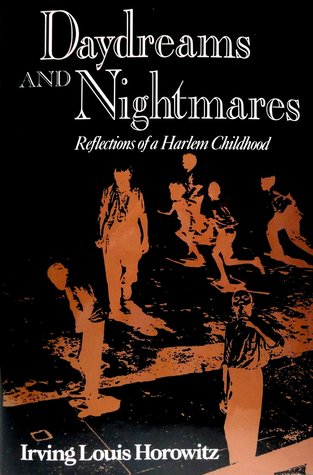To start with, the process of Americanization began at birth. Within the space of one week at the Metropolitan Hospital, I started life as a Hebrew child, with the name Yitzhak-Isaac. This apparently was too cumbersome for record-keeping purposes, so I was entered on the birth certificate as Isadore. But my sister, or at least so she told me, thought that name was far too Europeanized for a Harlem baby, so I became Irving by the seventh day. Louis is an affectation of my late teens—there had to be some way to distinguish myself from all the other Irvings who lived in the Bronx and Brooklyn.”
So begins Irving Horowitz’s remarkable memoir of growing up Jewish in Harlem. Readers be warned. This is no Neil Simon tale of adoring parents and precocious kids. The Horowitzes were not a happy family. The socialist father, who deserted the Czar’s army but nourished dreams of a Soviet Yiddish state, displayed no affection toward his family. Without the skills to succeed in the garment trade, he set up a key and lock shop in Harlem on the sound theory that such a business would do well in a highcrime area. The author gives us the impression that when his parents were not quarreling with each other or beating the children, they were staying one step ahead of their black neighbors. During Christmas season the family worked the bulb scam: unsuspecting black customers would bring in their bulbs for a test that usually revealed the lights to be defective. “When the same bulbs were retested after the customer left, they almost always were found to be perfect. . . . My father placed them into inventory and resold them as new.”
But if the Horowitzes picked up a few dollars with such tricks, the whole of Harlem, black and white, was devoted to the hustle, and young Irving goes from sneaking money from his father’s cash drawer to manipulating ticket sales at the Polo Grounds to running numbers and scalping tickets. What training for a political sociologist!
More than anything this is the story of a Jewish boy with a cleft palate making it the hard way on the streets of Harlem. After the great Harlem riot in which the family business is sacked, the Horowitzes move to pleasanter quarters in a Jewish section of Brooklyn. The young Horowitz—”a Jew with heavy traces of a black sharecropper’s accent”—brought Harlem with him to Brooklyn. His new classmates regarded him, not without reason, as a bully, and he got into real trouble with his one attempt to imitate the sexual mores of Harlem by attacking a girl whom he had never met. When all hell broke loose, he “kept wondering why Harlem kids seemed to manage sexual intercourse without incurring the wrath of parents and other authorities.” During his period of in-school suspension, he begins to see life from the principal’s perspective, and it took the tough-minded teachers of PS 193 only one term to turn him into a kid who would grow up to be a major American social theorist and the proprietor of a major academic press.
Even more interesting than Irving Horowitz’s personal story are his observations on the difficult relations between blacks and Jews. Like many Jewish kids, Horowitz was as fond of the blacks’ music as he was terrified of their unrestrained behavior. If blacks envied Jews for their particles of economic success in the I930’s, some Jews had a sneaking admiration for black creativity. However, “the majority of Jews, for their part, saw this flirtation with black culture as nothing short of a desecration of Jewish life—an early warning signal that sexuality would displace marriage and undiluted individual expression would destroy family solidarity.”
But for all the ambiguities of the relationship, suggests Horowitz, it was a black-Jewish partnership that to a great extent created modern American pop culture.”Even in the supreme black achievement of jazz . . . Jewish musicians—Goodman, Gershwin, Mezzrow, and Whiteman among others—not only played the music, but also served as critics and interpreters. In a racially controlled prewar America, it was the Jew who popularized black life, transforming a folk tradition into an art mode.” Blacks, who “saw their uniqueness compromised” by this cultural appropriation, inevitably resented Jewish success, believing that “the gain and fame of their culture went to the accursed Jewish cultural middleman, while the purity of their performance remained undersupported and undernourished.” But it is doubtful that black cultural forms would ever have enjoyed their triumph without the help of the “cultural middlemen” who made it acceptable for white audiences.
In making these observations, Horowitz has displayed considerable courage. The ethnic roots of American culture are buried under tons of official mythology, the slag of the melting-pot ideology, and given the choice between truth and legend, most writers and publishers will always “print the legend.” The childhood portrayed in Daydreams and Nightmares is a gritty little piece of reality, the irritant from which pearls are made.
[Daydreams and Nightmares: Reflections of a Harlem Childhood, by Irving Louis Horowitz (Jackson: University Press of Mississippi) 116 pp., $18.95]

Leave a Reply